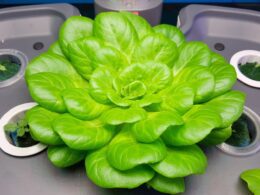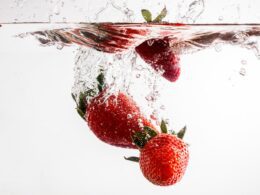Are you tired of the hassle of soil gardening? Do you want to try a new, easier way to grow plants? Hydroponic gardening might just be the answer you’re looking for!
Hydroponics is a method of growing plants without soil, instead using nutrient-rich water as the growing medium. This method has become increasingly popular in recent years due to its efficiency, versatility, and ease of use.
But where do you start with hydroponic gardening? What is the easiest plant to grow hydroponically? Don’t worry, we’ve got you covered.
In this article, we’ll discuss the benefits of hydroponic gardening and introduce you to some of the easiest plants to grow hydroponically. We’ll also provide tips and tricks for successfully growing plants in a hydroponic system.
By the end of this article, you’ll be ready to start your own hydroponic garden!
What is Hydroponics?
You’ll be amazed at how simple it is to cultivate a variety of greenery without soil through the innovative technique of hydroponics. Hydroponics is a method of growing plants in a nutrient-rich water solution instead of soil.
This technique has been around for centuries, with the first recorded use of hydroponics dating back to the ancient Babylonians. Over time, hydroponics has evolved into different types of systems, each with its own unique benefits.
Some of the most popular types of hydroponic systems include deep water culture, nutrient film technique, and drip irrigation. Deep water culture involves suspending plants in a nutrient-rich water solution, while nutrient film technique involves a constant flow of nutrient solution over the roots. Drip irrigation, on the other hand, involves a slow drip of nutrient solution onto the roots.
Hydroponics has come a long way since its inception, and it’s now easier than ever to grow plants hydroponically. With the right system and a little bit of knowledge, you can grow a variety of plants, from herbs and vegetables to flowers and fruits.
So why not give hydroponics a try and see how easy it is to grow your own plants without soil?
Benefits of Hydroponic Gardening
Hydroponic gardening has numerous advantages, making it an increasingly popular choice for indoor farming and sustainable agriculture. One of the biggest benefits of hydroponics is the ability to control the nutrients and growth of your plants. By using a nutrient-rich solution, you can ensure that your plants are getting exactly what they need to grow and thrive. This can result in faster growth, higher yields, and healthier plants overall.
Another advantage of hydroponic gardening is that it uses less water than traditional soil-based methods. Because the plants are grown in a water-based solution, there’s no need for soil, which can be a major source of water waste. In fact, hydroponic systems can use up to 90% less water than traditional farming methods, making them a much more sustainable option for those looking to reduce their environmental impact.
Finally, hydroponic gardening is also a space-efficient way to grow plants. Since there’s no need for soil, hydroponic systems can be set up in small spaces, such as a spare room or closet. This makes it a great option for urban dwellers or those with limited outdoor space.
With the ability to control nutrients, conserve water, and save space, hydroponic gardening is an excellent choice for anyone looking to grow their own food in a sustainable and efficient way.
Are There Any Plants That Are Both Easy to Grow Hydroponically and Cannot Grow Hydroponically?
There are indeed specific plants that cannot grow hydroponically. While many varieties thrive in hydroponic systems, others, such as potatoes, carrots, and peanuts, require soil for proper growth. These plants that cannot grow hydroponically rely on the nutrients and stability provided by soil for their development and overall health.
The Easiest Plants to Grow Hydroponically
If you’re new to hydroponic gardening, you may be wondering which plants are the easiest to grow. The good news is that leafy greens, herbs, and tomatoes are all great options for beginners.
With a little bit of research and preparation, you can easily grow these plants using hydroponic methods.
Leafy Greens
Leafy greens are a great choice for beginners looking to start their hydroponic garden. They’re easy to grow and require minimal maintenance. Here are three reasons why leafy greens are a perfect choice for your hydroponic garden:
-
Nutrient requirements: Leafy greens have lower nutrient requirements compared to other plants, making them easier to grow in a hydroponic system. This means you won’t need to worry about constantly adjusting nutrient levels in your water.
-
Growing techniques: Leafy greens are fast-growing and can be harvested multiple times in a season. They also do well in a variety of hydroponic systems, such as deep water culture or nutrient film technique.
-
Health benefits: Leafy greens are packed with nutrients and vitamins, making them a healthy addition to your diet. Growing your own hydroponic leafy greens ensures that you have access to fresh and nutrient-dense produce all year round.
Overall, growing leafy greens hydroponically is a great way to start your gardening journey. With their easy maintenance and health benefits, you’ll be able to enjoy a bountiful harvest in no time.
Herbs
You’re ready to take your hydroponic gardening to the next level with herbs. Not only will you be adding depth and complexity to your culinary creations, but you’ll also be enjoying the benefits of fresh, nutrient-dense produce all year round. Herbs for cooking are some of the easiest plants to grow hydroponically. They’re low maintenance and can thrive in a variety of growing conditions.
When deciding which herbs to grow, consider your favorite recipes and what herbs you use most often. Some popular choices include basil, cilantro, mint, and parsley. Additionally, growing medicinal herbs like chamomile, lavender, and rosemary can provide natural remedies for common ailments. Check out the table below to see which herbs are best suited for hydroponic growing and the ideal growing conditions.
| Herb | Ideal Growing Conditions |
|---|---|
| Basil | Temperature: 65-80°F pH: 5.5-6.5 Light: 12-16 hours/day |
| Cilantro | Temperature: 50-85°F pH: 6.0-6.5 Light: 12-16 hours/day |
| Mint | Temperature: 60-70°F pH: 5.5-6.5 Light: 12-16 hours/day |
| Parsley | Temperature: 70-80°F pH: 5.5-6.5 Light: 12-16 hours/day |
Get started with hydroponic herb gardening today and elevate your cooking game while reaping the benefits of fresh, healthy produce.
Tomatoes
Let’s dive into the world of hydroponic tomato gardening and discover how to cultivate juicy, flavorful tomatoes all year round. Tomatoes are one of the easiest plants to grow hydroponically, so you can have a bountiful harvest of delicious tomatoes with the right techniques and nutrients.
To successfully grow hydroponic tomatoes, here are some tips to keep in mind:
- Choose the right variety of tomato that suits your needs and preferences.
- Provide sufficient light and warmth for your plants to thrive.
- Use a nutrient solution that’s rich in nitrogen, phosphorus, and potassium.
- Monitor the pH level of your solution regularly to ensure optimal growth.
By following these tips and taking good care of your hydroponic tomato plants, you can enjoy fresh and tasty tomatoes all year round. With a little bit of effort and patience, you can become a successful hydroponic tomato gardener.
Tips for Successfully Growing Plants Hydroponically
It’s important to follow the tips provided to ensure successful growth of your hydroponic plants.
One of the most crucial things to keep in mind is the pH levels of your nutrient solutions. Make sure to regularly check and adjust the pH levels as needed, since plants can only absorb nutrients within a certain pH range.
Another important tip is to properly maintain your hydroponic system. This includes regularly cleaning and disinfecting your system, as well as keeping a close eye on your plants to ensure they are receiving enough light, water, and nutrients.
It’s also important to properly space out your plants and avoid overcrowding, as this can lead to poor air circulation and an increased risk of disease.
Lastly, remember to always use high-quality seeds and nutrient solutions. Hydroponic plants rely on their nutrient solution for everything they need, so investing in a good quality solution can make all the difference in your plant’s growth and health.
With these tips in mind, you’ll be well on your way to successfully growing plants hydroponically and enjoying a bountiful harvest.
Conclusion: Start Your Hydroponic Garden Today!
If you’re looking for a fun and innovative way to cultivate a variety of fresh, healthy produce in the comfort of your own home, there’s no better time to start your own hydroponic garden than now.
With a hydroponic set up, you can easily grow plants without the need for soil, making it an ideal option for those with limited outdoor space. Plus, hydroponics can be a great way to ensure that your plants receive the proper nutrients they need to thrive.
To get started with your hydroponic garden, you’ll need to invest in a few key items, such as grow lights, containers, and nutrient solutions.
One of the easiest plants to grow hydroponically is lettuce, as it requires minimal maintenance and can grow quickly in a hydroponic environment. Other popular options include herbs like basil and mint, as well as leafy greens like spinach and kale.
When it comes to nutrient solutions, it’s important to choose a high-quality product that will provide your plants with the necessary nutrients they need to grow. Look for nutrient solutions that are specifically designed for hydroponic gardening, as these products will contain the right balance of essential nutrients that your plants need to thrive.
With a little bit of time and effort, you can easily set up your own hydroponic garden and enjoy the many benefits of growing your own fresh produce at home. So, start your hydroponic garden today!
Frequently Asked Questions
What equipment do I need to set up a hydroponic garden?
When setting up a hydroponic garden, there are a few essential pieces of equipment you’ll need to consider. First, you’ll need to choose the right growing medium for your plants. Popular options include Rockwool, clay pellets, and coconut coir.
Next, you’ll need to decide on the appropriate hydroponic lighting options for your setup. LED grow lights are a popular choice for their energy efficiency and long lifespan.
Lastly, you’ll need to consider additional equipment such as nutrient solutions, air pumps, and pH meters to ensure your plants thrive. By carefully selecting your growing medium and hydroponic lighting options and investing in the necessary equipment, you can create a safe and successful hydroponic garden.
How often do I need to monitor the pH level of the nutrient solution?
To maintain a healthy hydroponic garden, it’s essential to monitor the pH level of your nutrient solution regularly. The optimal pH range for most plants is between 5.5 and 6.5, which ensures that the plants can absorb all the necessary nutrients.
There are various pH testing methods available, including pH test strips, digital pH meters, and liquid pH test kits. It’s recommended to test the pH level of your nutrient solution at least once a day or every other day, depending on the size of your garden and the type of plants you’re growing.
Don’t forget to adjust the pH level if necessary to keep your plants thriving. By keeping a close eye on your pH levels, you’ll ensure a healthy and productive hydroponic garden.
Can I use tap water for my hydroponic system?
Using tap water for your hydroponic system can be a cost-effective solution, but it’s important to be aware of the nutrient solution ingredients. Tap water may contain minerals and chemicals that can affect the pH level of the solution.
To ensure a healthy environment for your plants, you should monitor the pH level regularly and adjust as necessary. It’s also recommended to use a water filter to remove any impurities from the tap water.
Remember, the quality of the water directly affects the health of your plants, so take the time to ensure you have the best water possible for your hydroponic system.
What are the potential downsides of hydroponic gardening?
When it comes to hydroponic gardening, there are potential downsides to consider. One of the biggest downsides is the maintenance requirements. Hydroponic systems require a lot of attention and monitoring to ensure the plants are getting the right nutrients, pH levels, and water. If any of these factors are off, it can lead to plant failure.
Additionally, hydroponic systems can be expensive to set up and maintain, and there’s always the risk of equipment failure. But with proper care and attention, hydroponic gardening can be a rewarding and efficient way to grow plants.
How long does it typically take to see results when growing plants hydroponically?
When it comes to hydroponic gardening, you can typically see results much faster than traditional soil gardening. In fact, some plants can grow up to 50% faster in a hydroponic system.
However, the time it takes to see results can vary depending on the plant species, nutrient levels, and growing conditions. But if you follow the proper techniques and avoid common mistakes in hydroponics, you can enjoy the benefits of hydroponic gardening in no time.
These benefits include using less water, saving space, and avoiding soil-borne diseases. So if you’re looking for a quick and reliable way to grow plants, hydroponic gardening might just be the solution you’re looking for.
Conclusion
Now that you know the benefits of hydroponic gardening and the easiest plants to grow hydroponically, it’s time to start your own hydroponic garden!
Don’t be intimidated by the idea of hydroponics. It’s a simple and rewarding way to grow your own fresh produce. Plus, it’s eco-friendly and saves water compared to traditional gardening methods.
The key to successful hydroponic gardening is to start with the right plants and follow the tips for proper care. So, go ahead and give it a try – you’ll be amazed at how easy and fun hydroponic gardening can be!









